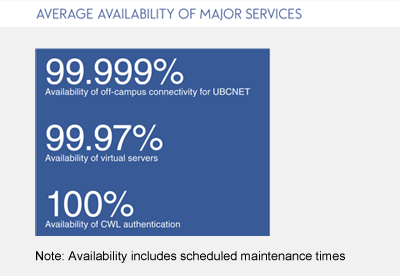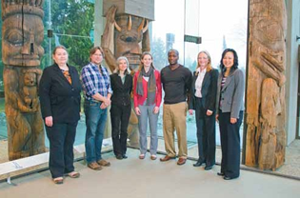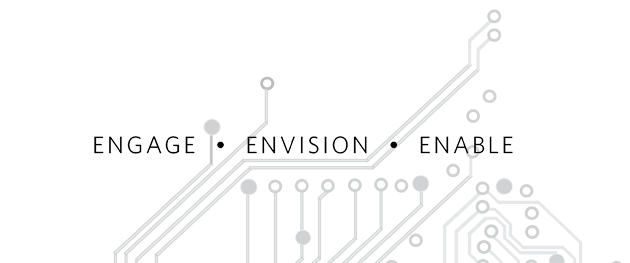Table of Contents
- Letter from the CIO
- About Us
- Key Focus Areas
- Sustainability - Virtualizing Computing at UBC
- Reliability - Information Security Program
- Cost Effective - UBC IT Web Services
- Collaboration - IT Career Framework
- Client Satisfaction: The Client Experience
- Future Outlook
Letter from the CIO

After a half-century of public investments and expansion, universities are now under pressure to reduce cost and streamline operations, as students and researchers demand ever more innovative study and working methods. The art is to make structural changes that can enhance teaching and research while improving effective use of our resources. Information technology services play a crucial role, as the rapidly evolving opportunities of cost-effective bandwidth, processing and functionality can contribute significantly to lower operating cost and a greater experience for students, teachers and researchers. The challenge is not in the local deployment of yet another free internet service, but in the appropriate integration of information flows, offering of scalable shared solutions and the reliable support of end-users. Finding this narrow path is today's challenge to all IT professionals at UBC, and I am proud of the university-wide collaboration we are proving capable of.
In response to this challenge, UBC IT has changed significantly in the past year— perhaps the most accelerated change in the history of the department. It has been a period of growth in many directions: we have grown through the integration of IT teams across the university; through the university's significant investments in information management solutions; and through the development of new capabilities and service offerings. All this expansion has resulted in substantial structural changes, which have challenged our staff and required much patience from our customers and partners across the community.
This annual report is produced in recognition of our staff's commitment to the aggressive evolution of shared IT services at UBC, and our partners' and customers' support of our rapid development. The report highlights specific new solutions and services, and through our website at www.it.ubc.ca, we present a full view of the offerings, projects and delivery mechanisms that have expanded UBC IT over the past 12 months.
I want to thank UBC IT staff for their everyday dedication and our partners for their collaboration as we look forward to the opportunities that lie ahead to build the future of IT at UBC.

Oliver Grüter-Andrew
Chief Information Officer, UBC

| Groups names and # of employees in each group | |
| 350 our employees by group (see breakdown on right) | 4 CIO Office |
| 100% academic buildings wireless-enabled | 4 Administration |
| 1500+ virtual servers | 4 Enterprise Architecture |
| 2772 desktops supported | 20 Audio Visual Services |
| 8000 internet ports in residence | 21 Digital Media Technologies |
| 13,066 UBC phone numbers | 40 Project Management Office |
| 21,303 vista courses | 44 Administrative Systems |
| 49,395 mailboxes supported | 46 Client Services |
| 2,000,000 gigabytes of information stored at UBC | 50 Academic Systems |
| 125,000,000+ Campus Wide Login authentications per year | 117 Infrastructure |
Key Focus Areas
In 2011, we continued our concentration on a few critical areas including sustainability, reliability, cost effectiveness, and collaboration.

Virtualizing Computing at UBC

We consider environmental sustainability in our IT solutions
From virtualizing our computing environment to reducing paper usage, together with our partners, we are engaging in new initiatives to reduce paper and energy consumption, and increase operational efficiency.
Reduction in carbon footprint is one of UBC's key goals, and in alignment with the university's carbon footprint target of reducing GHG emissions to 67 percent below 2007 levels by 2020, we've made major transformations in the delivery of servers and desktops through the use of virtualization.
Virtual Technology
There are many sustainable benefits to virtualization. Virtual machines have a longer lifecycle, resulting in reduced hardware consumption and maximized use of equipment, compared to physical machines. They are managed centrally, where one console can automate, update and deliver service to thousands of machines in minutes. With less hardware being used, energy consumption is lowered, which also leads to lowered overhead expenditures and environmental impact. In addition, less maintenance is required to support virtual equipment on a day-to-day basis, and deployment of a new virtual machine only takes a few minutes compared to a physical machine which may take weeks.
Virtualization of Servers
One server rack containing physical equipment is approximately seven-feet tall by two-feet wide and three-feet deep and can hold two to four larger-sized servers, or up to 64 smaller-sized servers. This fiscal year, we decommissioned 40 servers, decreasing approximately 10 server racks. Today, we only have four server racks remaining from 20 originally. This is an 80 percent reduction in space! Virtual servers lessen energy consumption by 70 to 80 percent. Users will notice that performance and production are dramatically improved as virtualization supports a more diverse systems environment and better utilizes server resources. In addition, virtual servers are more economical than physical servers. A physical server can cost $20,000 to $30,000 to replace, whereas a virtual server can cost as low as $125 a year and only requires a few additional software applications to maintain the service.
"Overall, we received some very positive feedback on the deployment. Our clients were impressed with the quick turnaround time and the improved performance," said Mario Angers, Manager of Systems.
The next phase for virtual servers includes improving the ease of management for service owners, and providing a real-time service for actual usage billing.
Virtualization of Desktops
Virtual desktops have the ability to share resources across many desktops. Using the technology of sharing one desktop image, a resource can be deployed to many virtual desktops at once. Today, approximately 785 virtual desktops are in place. Each virtual desktop uses 70 to 80 percent less energy than a physical PC desktop, lowering operating expenses up to 60 percent. Virtual desktops also offer more stability and security. All computing activity takes place behind a firewall as data transmission is happening internally and inside the network. If theft ever takes place and hardware is stolen, users' work will not be disrupted and no data will be lost as work is not stored locally. Mobility is another added benefit to virtual desktops. Users can access their work on their desktop anywhere in the world as long as they have a network connection available to them.
An initial pilot project was in place for 80 administrative staff within UBC IT and for various departments in the Old Administration Building. Other faculties that have been running trials with virtual desktops this past year include: Medicine IT, Sauder, Science, Dentistry, Finance and Human Resources.
"We received great feedback from clients. They found it to be very reliable and stable. They loved the mobility and flexibility that it provided," stated Robert Padwick, Manager of Desktop Services.
The roadmap for virtual desktops is a continuous one as further deployment of the equipment will take place for departments and faculties. Infrastructure improvements are also expected in order to provide an even more flexible and cost-effective way for deployment and management of the service.
In 2012, we will continue to virtualize initiatives by consolidating our infrastructure for a more sustainable IT. 



| Activity / Project | Goal | Results / Accomplishments to Date |
| Energy Savings | ||
| Server Virtualization | Reduce number of physical servers in use at UBC |
|
| AV Systems | Decrease energy consumption and extend equipment life of AV systems |
|
| Virtual Desktops | Decrease energy consumption of desktop computers |
|
| Paper Reduction | ||
| Student Information Systems Renewal Project | Reduce paper consumption by reducing printed reports |
|
| HR and Payroll Systems | Reduce paper consumption through electronic T4 tax form distribution |
|
| UBC Directory | Reduce need to self- print directory pages by offering alternate method of accessing the UBC Directory |
|
| Electronic Personnel Action Forms (ePAF) | Reduce paper consumption through use of electronic forms |
|

Information Security Program

By using current, stable technologies, project management, and improved procedures, we enhance quality, throughput, and performance of IT systems. Our policies and practices provide mitigating actions and minimize risk for any unexpected service degradations or outages. This year, we continued regular hardware refresh cycles to ensure our infrastructure is current, application upgrades to provide an optimal functionality, stability, and user experience, and security enhancements to protect the data of the university.
UBC IT has implemented an Information Security Program in order to ensure a safe and secure computing environment at UBC. The Program is led by the Information Security Task Force, which is chaired by Andre Ivanov, Head of the Department of Electrical and Computer Engineering and has its membership rooted across faculties and administrative units. Larry Carson, Associate Director of Information Security Management, spearheads information security for UBC and is responsible for the strategic planning and development of the program, under the overall direction and authority of the Information Security Task Force. His work with the program involves engaging the university community to collaboratively design improvements that meet the needs of the institution, as identified by the University Executive, while facilitating a positive culture shift towards the better management of information assets and their security. This five-year program will help each department and administrative unit to better understand and manage IT risks as they pertain to their information assets.
The Program
The Information Security Program consists of self-assessment tools, policies, and standards to support compliance with the University's policies and expectations on the security of information. This self- help tool suite will be made available to unit IT managers, to carry out the activities and tasks under their control. It will be updated and used annually in combination with additional online information security awareness education, which was implemented this year for all faculty, staff and graduate students at UBC.
"Laptops and portable drives can sometimes contain highly sensitive information, and at a time when these devices are being lost or stolen, organizations are struggling to identify where their information is being stored and how it's being protected. This Program is designed to empower management, such as Department Heads, Deans, VPs and the Board, to be able to make informed risk-aware decisions, with respect to the security of the institution's information." Larry Carson, Associate Director for Information Security Management.
A pilot of this Program has already been tested with two academic units: the Department of Electrical and Computer Engineering and the Faculty of Pharmaceutical Sciences and the results have been positively received.
"Members in ECE are pleased to contribute to increasing the awareness regarding importance of IT security. This pilot does this and more by taking us into the right direction as a community." Andre Ivanov, Department Head for Electrical and Computer Engineering and Chair of the Information Security Task Force.
"Never before has it been as important for academic units to assure the safeguarding of their information. It has been a real pleasure to work with UBC IT on this project." Robert D. Sindelar, Ph.D., Professor and Dean, Faculty of Pharmaceutical Sciences.
The Information Security Program is currently being implemented beginning with UBC Faculties in both Vancouver and the Okanagan. The breadth of the Program will be built-out over the duration of the five-year Program, with further depth and maturity being developed following initial rollout.
Further Measures to Increase Security
In conjunction with the launch of the Information Security Programme, UBC IT is also taking security measures in other areas. With the implementation of a new storage service at UBC Okanagan, UBC IT can now back up all its data to the Okanagan, allowing data to be kept onsite instead of backing up to tapes which were taken off-campus for secure storage with a vendor. An added benefit to implementing storage at UBC Okanagan is that it can also be used to provide secure storage for other BCNET universities and some universities such as SFU are already planning to store their data using the new infrastructure.
UBC IT has also made virtual desktops available that protect data, normally stored on desktop computers, from loss due to theft; when deployed with thin clients, replacing the desktop computer, the virtual desktop functions similarly to a desktop computer but the thin client hardware actually contain no data. Should the thin client be stolen, there is no risk of data loss, as it is stored only in the virtual server environment in the data centre.
Looking ahead, UBC IT is moving towards having a single login account per user which will be able to access multiple applications starting with Enterprise Active Directory (EAD). Using EAD, we can ensure that (a) passwords are being used, (b) the passwords used are complex, and (c) passwords are changed on a regular basis. Complementing this, UBC IT is also currently working to enable computer encryption, especially for laptops, which tend to be at higher risk of being stolen. With a strong password in place, coupled with effectively implemented encryption, in the event of a laptop being lost or stolen, data on the laptop would not be accessible.
At UBC IT, information security is of utmost importance and we are continually taking measures to ensure that our systems are secure, and data is safe. Moving forward, the Information Security Program provides a framework for security at UBC and within that framework we will continue developing future security enhancements such as encryption for tablets and mobile devices. For more information about the Program visit cio.ubc.ca/information-security. 
How It Works
There are five steps in the Information Security Program:
| 1 | Each department or unit completes a list of questions about their information assets. Feedback from this questionnaire will immediately be generated by a Prioritization Tool and participants will be able to easily identify their highest priority data assets. |
| 2 | A Risk Assessment is conducted to understand the level of risk for their highest priority asset. |
| 3 | A Gap Analysis will then be used to help the team identify the amount, if any, of improvement or changes that are required in order to meet the University's policies and standards for information security. |
| 4 | At the Risk Treatment stage, risks on the top information assets are reviewed and appropriate controls are applied, with the appropriate level of security indicated for that type of data. |
| 5 | Finally, a Self-Audit is conducted to determine if security controls and processes have been implemented correctly and in accordance with University's policies and standards. |



| Activity / Project | Goal | Results / Accomplishments to Date |
| Hardware Refresh | ||
| Phone Service | Increase reliability of phone services by replacing aging hardware |
|
| Network Lifecycle | Replace networking equipment on a seven-year lifecycle |
|
| AV Systems | Increase ability to monitor AV systems across campus |
|
| Application Upgrades | ||
| Student Interaction Transformation Program – Student Information System (SIS) Renewal | Ensure SIS infrastructure provides a reliable and robust foundation to support Enrolment Services mission critical business |
|
| CWL Database Virtualization | Maintain stability of CWL and improve Disaster Recovery capability |
|
| Improve reliability by replacing aging email system |
| |
| Infrastructure Monitoring Systems | Improve networks, servers and applications monitoring capabilities |
|
| Security Enhancements | ||
| Information Security Program | Increase overall information security of data at UBC |
|
| UBC Wireless | Increase security of the wireless network |
|
| ePayment Gateway | Align credit card payments at UBC with industry standard security |
|
| Personal Home Drive Storage Space | Manage information risk by providing UBC faculty and staff with a secure, and fully redundant storage space |
|

UBC IT Web Services

We promote financial sustainability and deliver transparency with respect to associated costs. We invested in critical infrastructure, maximized return on investment, and managed variable spending while absorbing significant growth. We are currently integrating with a number of IT groups across campus in order to consolidate IT spending at UBC and leverage economies of scale. This trend will continue into 2012 and 2013.
UBC IT's Web Services team delivers innovative, interactive websites at rates significantly below outside vendors. How are they able to do this? They leverage the ideas and solutions that they deploy across campus and extend them for each website resulting in cost savings to the university. There is no profit made from any of the projects the team works on; the websites developed for faculties and departments are all done at cost, as the mandate of the team is to assist the university units in creating websites at a sustainable cost.
The Service
The Web Services team, led by Jan Carter, Manager of Web Services at UBC IT, offers a complete web service package–that is, they design, develop, host and maintain websites (including mobile sites) and web applications for faculties, departments, sub-units, and researchers. The service includes back- up solutions to ensure data is not lost and the service keeps running in the event of an outage. Jan leads a team of nine staff including developers, designers, and content specialists.
IT Savings
In addition to being not-for-profit, the Web Services team is able to achieve savings for the University in terms of IT because it has much lower overhead costs than off-campus web design and development agencies. For example, the team is able to achieve cost savings by leveraging the existing infrastructure set up for the department as a whole, such as space usage and utilities, as well as administrative costs for tasks such as billing clients. With a core team of development staff, resources can also be reallocated depending on need, and with a larger team, there are also continuous professional development opportunities for the team members themselves. In addition, for elements that recur for multiple websites (such as the UBC common look and feel banner), the start-up cost of creating these have already been invested, and can be used and changed as needed.
Creating websites in the higher education environment requires a familiarity with the policies of the University and of the Province such as the Freedom of Information and Protection of Privacy Act, applicable in BC. The integration of calendars and shopping carts also can be different in a higher education environment. Since the Web Services team is operating specifically in the higher education environment, and more specifically, the UBC environment, they are already familiar with the policies and procedures that need to take place.
Customers such as the UBC Bookstore are extremely satisfied with the service received. Rebecca Irani, Communications Manager at the UBC Bookstore says, "We would recommend Web Services due to the project management that we experienced, as well as the design of the website, which we felt was spot on. Web Services was also cheaper–their costs can be a third off the price of an outside agency."
The Future
Since its inception in June 2010, the Web Services team has completed 42 websites for different units on campus, totaling over 15,000 webpages. The team continues to grow to include more staff and expanded skill sets such as responsive designers, mobile developers, and usability specialists. 


| Activity / Project | Goal | Results / Accomplishments to Date |
| Economies of Scale | ||
| Web Services | Decrease cost for web development on campus |
|
| Enterprise Desktop Support | Provide scalable, cost- effective desktop services |
|
| Virtual Server Service (VSS) and Storage Service | Decrease cost for Virtual Server Service and Storage Service and increase return on investment on equipment |
|
| BCNET Network | Increase savings in procurement of equipment |
|
| Internet Service | Maintain current service level at lower cost through use of peering services |
|
| UBC Survey Tool | Provide a cost-effective, Canadian survey tool for faculty and staff use |
|
| Software Licensing | Decrease overall costs for software licenses by implementing a single toolset for software development |
|
| Streamlining Processes | ||
| Collaboration Platforms | Reduce IT collaboration platforms such as email, storage, and virtual servers |
|
| Classroom Audio/ Visual Support | Simplify operations and reduce administration costs with new structure and funding for Classroom Audio/Visual Support |
|

IT Career Framework
By working with the UBC community and coordinating mutual activities, we deliver IT solutions that are the best for UBC, support UBC's commitments and achieve UBC'S vision.

UBC IT values the collaborative process and seeks the opinions of our clients, customers, and end -users in the decision-making process. We strive to ensure that stakeholders have a voice in shaping the future of IT at UBC. This past year we engaged in a number of collaborative initiatives with our partners, and delivered services that facilitate collaboration with others.
With over 600 IT professionals at UBC, the challenge for IT at UBC was the difficulty in identifying what career positions existed in a geographically dispersed environment. In response to this, UBC's CIO initiated a collaborative project to develop a standardized IT Career Framework for UBC. The purpose of the project was to develop a model to facilitate recruitment, selection and career development by standardizing and aligning all IT job descriptions on campus, providing role clarity and performance measurements linked to organizational performance and strategic direction.
The Career Framework would enable IT professionals on campus to easily determine the positions and career paths available to them, and also identify staff members with similar roles for knowledge sharing opportunities. In addition, the Career Framework would create equity in the workplace by providing fair compensation for equivalent roles, and equal opportunities for career advancement.
Collaboration
As a collaborative initiative between HR and IT professionals at all levels at UBC, UBC IT is currently taking part in the IT Career Framework program alongside three other campus IT groups: MedIT, UBC Okanagan, and the Centre for Teaching, Learning and Technology (CTLT). The four groups were purposely selected as part of the program, as they were the most geographically diverse and included the widest variety of IT positions. Working with these groups would result in better identifying and addressing the most common roles in IT before expanding the framework to other IT groups on campus in the future.

Cable Installation and Repair Serviceperson
UBC IT worked together with MedIT, UBC Okanagan, and CTLT to study work done in other educational institutions, to understand common best practices, and to run a series of interactive focus groups across the university. Over 300 unique IT job descriptions at UBC were standardized and aligned into 13 distinct Career Ladders and 48 unique job positions
The IT Career Framework reflects Human Resources expertise in compensation, change management, systems and organizational development as well as the knowledge of IT hiring and management contributed by the four IT groups on campus.
Results
In August 2011, the implementation of the IT Career Framework was met with great success. It enabled visibility into what IT positions exist on campus, and provided a standardized method of assigning business titles of IT professionals. In addition, it clearly identified the skills and competencies required for the various IT positions, enabling IT professionals at UBC to see their current positions in the context of the entire IT workforce.

IT Service Centre
The Career Framework has received positive reviews by its participating employees. Lois Cumming, a UBC IT Identity and Access Management Manager explains, "The significant benefit for managers is the work that was done on the Career Framework streamlines the recruitment process. In the past, developing job descriptions and establishing the appropriate pay grade was a slow, often misunderstood process. This caused delays in hiring, which in turn impacted UBC IT's ability to deliver new systems and services in a timely manner."
The Future
With UBC IT currently integrated with different IT departments across campus, we actively introduce the systemized framework through each transition. We are also currently collaborating with other IT groups on campus to determine how and when the framework can be implemented across the rest of IT at UBC. The final outcome of the IT Career Framework project will provide guidance to UBC HR's Focus on People project, which seeks to provide a global career framework for all employees at UBC. After a successful pilot, the Career Framework Program is now available to all IT professionals at UBC. For more information about the program visit www.careerframework.ubc.ca. 

Clients We Are Supporting
| We provide desktop and IT support to the following clients: | |
|
|


| Activity / Project | Goal | Results / Accomplishments to Date |
| Community Engagement | ||
| IT Career Framework | Provide a career development and competency-based learning framework for IT employees at UBC in collaboration with UBC HR's Focus on People |
|
| IT Service Management (ITSM) | Improve customer- facing IT service delivery and support by implementing ITSM processes and tools |
|
| Innovate Incubate Operate (IIO) Framework | Increase collaboration with groups across the University in generating enterprise service ideas |
|
| Client Service Management | Maintain regular contact with units and departments to improve transparency and delivery of service |
|
| Community Feedback | Involve the community in IT decision making and service improvement |
|
| Collaboration Services | ||
| Digital Signage | Provide visitors and the UBC community a consistent experience in receiving information through digital signage |
|
| Storage Service | Provide backup storage to other BCNET universities while improving reliability and security |
|
| Unified Messaging | Increase flexibility for voice mail by integrating voice messages and emails |
|
| Student Interaction Transformation Program | Improve the way UBC interacts with students |
|

The Client Experience

UBC IT is committed to providing technology that enables exceptional learning and research, in an efficient and sustainable manner. As part of our approach, we have been asked to deliver services to units across campus. The Museum of Anthropology (MOA) was the first unit to approach UBC IT in 2010, and through initial discussion, became the first unit to have its IT support delivered by UBC IT. We recognize that adapting to changes and being a part of a new department can be challenging. UBC IT ensures a smooth transition to joining a new team as it is pivotal in order to meet the needs of the UBC community.
With a team of 33 staff and 160 students and volunteers, MOA is a world-renowned museum showcasing exquisite First Nations and world collections, and providing leading research, teaching, and public programs. MOA began integrating with UBC IT in spring 2010 after completing its building expansion and renovation project. With newly added space and more projects coming in, a more robust IT infrastructure was needed to support the expansion. MOA faced the choice of either using more resources to hire additional IT staff or leveraging UBC IT's resources and services. The answer was obvious. Today, MOA is extremely satisfied with their decision to join UBC IT. They feel at ease because they can find the IT expertise that they need, and they have built a fantastic rapport with their Client Service Manager.
Integration can have its challenges. As expected, there was some anxiety at the beginning of the transition process. One of MOA's concerns was that integrating would result in adapting to standard procedures that would not fit with MOA's needs. Working with their Client Service Manager, they were able to address these concerns in a timely manner and customize solutions that met MOA's IT needs.
Infrastructure changes that were made for MOA included migrating of storage to UBC IT's SAN, migrating of physical servers to UBC IT virtual server environment and migrating desktop support to UBC IT and switching their email system to FASmail (UBC IT's Faculty and Staff Email service). Technical issues are now addressed through the UBC IT Service Centre, which provides the flexibility of resolving multiple technical issues at the same time.

"Overall, MOA's transition to UBC IT has been a rewarding experience. We have grown to trust their team as they continue to work closely with us to address our needs. Our Client Service Manager took time to understand what MOA's specific needs were and made sure our issues were adequately addressed before we embarked on the transition. We have been able to access a range of UBC IT resources and feel confident that we will continue to work collaboratively to ensure MOA's IT requirements are met," said Mawuena Glymin, MOA's System Integration Analyst, and Moya Waters, Associate Director.
In addition to the Museum of Anthropology, 24 other units and departments have joined UBC IT, which include School of Architecture and Landscape Architecture, UBC School of Nursing, Enrolment Services, and School of Population and Public Health (3rd floor unit).
"I was delighted to hand over our IT requirements to UBC IT as I could see the benefits of having a larger resource pool available, as well as the benefits to our IT people in terms of career progression. The handover went smoothly, was professionally handled for a seamless transition. Although initially it was an adjustment for some people, as they went from calling one of two people when they had an issue, to now having a variety of assistance at their disposal, they quickly realized the benefits of the larger pool of talent to draw from to help solve their problems," said Patricia Stevens, Executive Director of President's Office at Old Administrative Building.
School of Architecture and Landscape Architecture's Assistant Professor, Blair Satterfield stated, "UBC IT went above and beyond to ensure that our needs were met. Due to the nature of our learning environment, we require a pretty demanding IT culture. We use a lot of specialized equipment. UBC IT understood our needs very well and was able to support the services we require."
UBC IT offers options to the university's many independent operating units for both IT resources and support. Working closely with IT units across campus will help ensure that technology needs are met at UBC. As more units collaborate more closely with UBC IT in the future, we will make it our focus to address their needs and concerns in order to sustain a rich and rewarding learning and research environment. 



Throughout this report, we have examined how UBC IT's operations has transformed information technology at UBC. We will continue this transformation in 2012, in our endeavour to support UBC's Vision.
Student Interaction Transformation Program
The Student Interaction Transformation Program (SITP) is a five-year program focused on transforming the way UBC interacts with students to support a holistic learning experience and UBC's commitment to student learning. The first year's accomplishments have laid the foundation for more visible changes to come which will have a positive impact on students, faculty and staff.
Over the next year the program will focus on a number of key areas to:
Support student-centric enrolment services: Building on the successful launch of the new application process and broad based admissions criteria and evaluation, the focus for next year will be to streamline the admissions process. This will include integrating a number of areas into the application such as housing and student financial assistance and awards. Additional focus will be placed on identifying synergies among SITP initiatives and the new Enrolment Services - Service Delivery model in support of student-centric processes.
Enhance our learning environment: Transforming our learning environment will continue to be a priority with significant enhancements to the Student Information System (SIS) and the continued rollout of the new Learning Management System (LMS). The LMS will provide instructors, staff, and students with a foundation for improved content managemenet, integration capabilities and a community of practice supporting new ways of teaching through the use of technology.
Support student's academic success: The rollout of the Early Alert system will be expanded to all faculty members across campus ensuring that students with academic, financial, mental health or other issues are identified early and are connected to the appropriate resources to get back on track to academic success. The Online Advising Management System (OAMS) will be rolled out to faculty advising offices across campus to support students by helping them make informed, educated and relevant choices.
Mobile Framework
UBC IT will be implementing a mobile framework to support the growth of mobile device usage by providing a campus-wide solution that includes mobile web services and mobile websites. With a mobile framework in place, users will be able to navigate the university using their smartphones, tablets, and other mobile devices. The mobile solution will be device independent and will be compatible with all browser-enabled phones allowing users to view UBC websites seamlessly on any mobile platform.
With the implementation of a mobile solution at UBC, users will be able to obtain information, such as directions, to a high degree of granularity using the location information provided by their device. Mobile web services will be available via a mobile portal (m.ubc.ca) that includes modules for key services such as maps, transportation, emergency alerts, admissions, dining, and libraries. In addition, we will be updating and mobile-enabling core UBC sites such as the Students Services website. An intitial stage of this framework will be launched in the summer of 2012.
The Mobile Framework Project is a collaborative effort in partnership with many groups on campus including the University Executive, UBC Public Affairs, Student Services, and Campus and Community Planning. We will also be implementing a community development program that encourages open development and sharing with other schools that use the common mobile framework. Over the next year, we will be seeking community input and engaging stakeholders across campus. 

